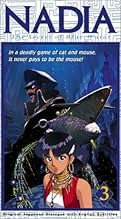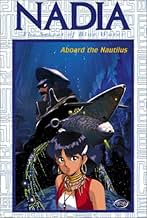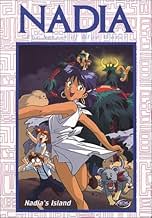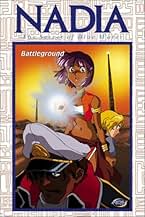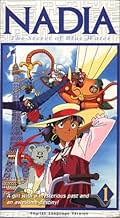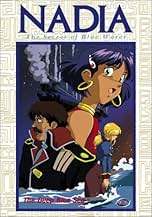Nadia - Il mistero della pietra azzurra
Titolo originale: Fushigi no Umi no Nadia
VALUTAZIONE IMDb
7,7/10
2225
LA TUA VALUTAZIONE
Una adolescente acrobata dalle origini misteriose e un giovane inventore si ritrovano invischiati in una trama sinistra che coinvolge il destino del mondo.Una adolescente acrobata dalle origini misteriose e un giovane inventore si ritrovano invischiati in una trama sinistra che coinvolge il destino del mondo.Una adolescente acrobata dalle origini misteriose e un giovane inventore si ritrovano invischiati in una trama sinistra che coinvolge il destino del mondo.
Sfoglia gli episodi
Recensioni in evidenza
Possible spoilers ahead.
I don't know what I can possibly say about this phenomenal series that hasn't been said already, but I'm here to try anyway. From the moment I saw a review of this series in Gamefan magazine (rest in peace), I fell in love. I had to see it. I dashed out to the mall and grabbed the first copy I saw. And it grabbed me right back, and would not let me go.
The series uses 20,000 Leagues Under the Sea (and to a lesser extent the sequel Mysterious Island) as a jumping point for its own story. It takes place in 1889, and revolves around two teens, Jean, a French boy who wants to change the world with inventions and is the biggest weenie who's ever been the hero of an anime, and Nadia, a circus acrobat and animal trainer who has a magical crystal, the Blue Water, and no clue about where she comes from. During the course of things they embark on an adventure to get to the bottom of Nadia's past, meet Captain Nemo and help to stop a group of people from Atlantis from taking over the world. And I loved every minute of it.
I mean for crying out loud, what kind of mad genius does it take to make episodes on end of adjusting to life on a submarine entertaining? Whatever kind it is, the guys at Gainax had it. Their smarts in storytelling show in other areas too, mainly the finely tuned characters, like the obligatory kid, Marie, who manages to be anything but the obnoxious brat the kid in an anime series almost always is. Nadia's the only short-tempered anime girl I've ever actually liked. The Grandis Gang go from the comically inept antagonists to helpful and resourceful back-up for the other characters once the real menacing villains show up. In the two really big battles of the series it's arguably them who ultimately save the day.
It does warrant mentioning that this show kind of flounders in the middle, owing to a bunch of quickly-proudced episodes that were shoehorned in to pad out the length of the series when it became an unexpected hit. Most of the mid-to-late 20's of Nadia can be skipped without missing anything worth seeing.
If you're an anime fan, want to watch a series with people in it you'll care about, and don't mind being expected to root for a dork like Jean, please do yourself a favor and pick this up. Oh, and do yourself another favor and watch it with the subtitles on. I'm sure Nathan Parsons is a wonderful human being who'd give me the shirt off his back, but a friend of mine actually started laughing out loud at how dumb Jean's voice sounded when we watched it with the English voices.
And before I go, I want affirm what everyone else is saying, that the sequel movie is terrible and should be avoided by fans of the series at all costs. Unless you want to see how badly a story can undermine itself (pretty much every suspense issue is defeated by watching the series epilogue and twenty five minutes straight of the movie is series flashbacks). Otherwise, stay away. You'll thank me.
I don't know what I can possibly say about this phenomenal series that hasn't been said already, but I'm here to try anyway. From the moment I saw a review of this series in Gamefan magazine (rest in peace), I fell in love. I had to see it. I dashed out to the mall and grabbed the first copy I saw. And it grabbed me right back, and would not let me go.
The series uses 20,000 Leagues Under the Sea (and to a lesser extent the sequel Mysterious Island) as a jumping point for its own story. It takes place in 1889, and revolves around two teens, Jean, a French boy who wants to change the world with inventions and is the biggest weenie who's ever been the hero of an anime, and Nadia, a circus acrobat and animal trainer who has a magical crystal, the Blue Water, and no clue about where she comes from. During the course of things they embark on an adventure to get to the bottom of Nadia's past, meet Captain Nemo and help to stop a group of people from Atlantis from taking over the world. And I loved every minute of it.
I mean for crying out loud, what kind of mad genius does it take to make episodes on end of adjusting to life on a submarine entertaining? Whatever kind it is, the guys at Gainax had it. Their smarts in storytelling show in other areas too, mainly the finely tuned characters, like the obligatory kid, Marie, who manages to be anything but the obnoxious brat the kid in an anime series almost always is. Nadia's the only short-tempered anime girl I've ever actually liked. The Grandis Gang go from the comically inept antagonists to helpful and resourceful back-up for the other characters once the real menacing villains show up. In the two really big battles of the series it's arguably them who ultimately save the day.
It does warrant mentioning that this show kind of flounders in the middle, owing to a bunch of quickly-proudced episodes that were shoehorned in to pad out the length of the series when it became an unexpected hit. Most of the mid-to-late 20's of Nadia can be skipped without missing anything worth seeing.
If you're an anime fan, want to watch a series with people in it you'll care about, and don't mind being expected to root for a dork like Jean, please do yourself a favor and pick this up. Oh, and do yourself another favor and watch it with the subtitles on. I'm sure Nathan Parsons is a wonderful human being who'd give me the shirt off his back, but a friend of mine actually started laughing out loud at how dumb Jean's voice sounded when we watched it with the English voices.
And before I go, I want affirm what everyone else is saying, that the sequel movie is terrible and should be avoided by fans of the series at all costs. Unless you want to see how badly a story can undermine itself (pretty much every suspense issue is defeated by watching the series epilogue and twenty five minutes straight of the movie is series flashbacks). Otherwise, stay away. You'll thank me.
Before anime characters started sporting gravity defying hair and using freaky psychic powers to subvert the laws of physics, we got a few gems like these. Nadia is one of the most popular series of the 80s and one of the best looking, especially over the first few episodes. The visuals are breathtaking and the action is edge-of-your-seat exciting. The action is driven by exciting stunts and the (then) cutting edge inventions from the age of steam make for wonderfully unpredictable getaway vehicles. The first episode alone has one of the best anime chase scenes of the period, as memorable as anything in Castle Cagliostro, and the excitement keeps up from there. The 'villainous' trio pursuing the main character are my only real complaint with the series; they are meant to be both threatening and comical, but they just come off as goofy and tend to get in the way. The pace also tends to slacken a bit after episode two, but the rest of the series is still worth watching for its likable characters and gorgeous visuals. The first couple of episodes are maybe the best in the series and start things off at a frenetic pace, making for memorable entertainment and good fun.
i bought a package of various bootleg anime series (bad, i know) and spent a few months muddling my way through them all. some were really good (pretear, love hina) some grew on me (macross 7) and some flat-out stunk. (to heart, and ironically, the series for which i bought the bundle, angelic layer) i approached them all with a certain amount of skepticism and nadia was no different. the story takes place in the 1880's and spent its first few minutes placing the viewer within the frame of the times. however, a few minutes later the story introduces the villains/heroes known as the grandis gang and their apparent mastery of a level of technology unavailable now 100 years later. so if anachronisms and anthropomorphisms bug you, nadia won't appeal to you.
as the plot develops, the characters take on depth and voice and you can't help but be charmed. the story becomes complicated and textured and not a little dark. then suddenly the first act closes and the second begins by abruptly changing from a tense drama into a wile e. coyote cartoon. then as soon as you settling into the admittedly funny and loopy island adventures, the series swiftly switches back into its formerly dramatic theme. so if wild swings in tone bug you, nadia won't appeal to you.
can a series flip and twist back and forth between drama and slap-stick comedy and still work? watch nadia for yourself and you be the judge. i found myself forgiving its flaws because it created characters i cared about, who seemed to have the depth to consider who they themselves were and what motivated them. the series lovingly embraces its characters flaws rather then exploiting them. (as was the case in evangelion, also by hideki anno) i forgave the surreality of the plot because it had the profound insight and courage to craft REAL teenagers. (i know a real kid who in his loving teenage cluelessness could have written jean's painfully funny "nadia" song) i especially appreciated the fact that marry's 5-year-old character wasn't nearly as obnoxious as she could have been. nadia could have been done differently, eliminating either its most serious moments or its most ridiculous, but it might not have been the same.
somewhere between the wide swings of our own pendulum is where real life happens.
p.s. there is a movie. it stinks, and adds nothing to anyone or anything in the story. resist the temptation to find it or watch it.
as the plot develops, the characters take on depth and voice and you can't help but be charmed. the story becomes complicated and textured and not a little dark. then suddenly the first act closes and the second begins by abruptly changing from a tense drama into a wile e. coyote cartoon. then as soon as you settling into the admittedly funny and loopy island adventures, the series swiftly switches back into its formerly dramatic theme. so if wild swings in tone bug you, nadia won't appeal to you.
can a series flip and twist back and forth between drama and slap-stick comedy and still work? watch nadia for yourself and you be the judge. i found myself forgiving its flaws because it created characters i cared about, who seemed to have the depth to consider who they themselves were and what motivated them. the series lovingly embraces its characters flaws rather then exploiting them. (as was the case in evangelion, also by hideki anno) i forgave the surreality of the plot because it had the profound insight and courage to craft REAL teenagers. (i know a real kid who in his loving teenage cluelessness could have written jean's painfully funny "nadia" song) i especially appreciated the fact that marry's 5-year-old character wasn't nearly as obnoxious as she could have been. nadia could have been done differently, eliminating either its most serious moments or its most ridiculous, but it might not have been the same.
somewhere between the wide swings of our own pendulum is where real life happens.
p.s. there is a movie. it stinks, and adds nothing to anyone or anything in the story. resist the temptation to find it or watch it.
Set in Pairs, France 1889, young inventor, Jean Roque Lartigue while showing off his latest aircraft at the Parisian Exposition comes across young orphaned dark skinned circus performer Nadia and her pet lion, King and becomes smitten with her. Jean by chance encounter helps Nadia elude Grandis Granva and her two henchman Sanson and Hanson who desire a jewel in Nadia's possession known as the Blue Water. While Nadia is reluctant to accept Jean's help and friendship the two eventually form a bond and begin traveling via Jean's unreliable aircraft in search of both Jean's missing father and Nadia's missing past. Along the way the two join up with Captain Nemo and his crew on board the submarine, The Nautilus, as Nemo and his crew fight against an enigmatic villains known as the Neo Atlanteans headed by equally mysterious Lord Gargoyle who plan to use extraordinary technology to take over the world.
Running for 39 episodes from 1990 to 1991, Nadia: The Secret of Blue Water's origins go back to the 1970s when the show began as an outline by none other than Hayao Miyazaki. Miyazaki's outline then titled Around the World Under the Sea took heavy influence from Jules Verne particularly 20,000 Leagues Under the Sea, and whole the project was never made, elements were reused in Miyazaki's subsequent works such as Future Boy Conan and Castle in the Sky. Gainax after being approached by Toho to produce a show for NHK, the staff of Gainax came across Miyazaki's outline and became captivated by it. Production on the show was tumultuous with Hideaki Anno often working as much as 18 hours a day trying to get the show done and having Shinji Higuchi to take over the direction from episodes 23 to 34 while Anno worked and finishing the final five episodes (which lead to the infamous "island episodes").
Viewing Nadia: The Secret of Blue Water is an experience. What starts out as a high adventure science-fantasy inspired by the works of Jules Verne soon moves to the background as the show shifts focus to analysis of characters and relationships with the main plot used more as a bridge for transitioning and exploring these character moments. The primary storyline of the show with the instigating mysteries of Nadia's origins or Jean's search for his father lost at sea are often relegated to the background as we see Nadia and Jean explore their characters in interactions with various side characters both major and minor we meet throughout the show. While the tone of the show starts out fairly light and optimistic, the show gets progressively darker (for the most part, but we'll get to that) with Nadia's search for answers to who and what she is often leaving her more lost than before and Jean's love of science and engineering challenged as he sees the darker side of scientific prowess used for conquest and murder.
The show feels like it's the product of two clashing visions as episodes such as "Run, Marie, Run!" have that childlike whimsy that characterizes much of Miyazaki's work with the focus of the episode being the youngest character Marie who spends much of the episode frolicking and playing with no real sense of direction plotwise until the final third, then other episodes are more indicative of Anno's work with The Mystery of the Lost Continent containing many scenes wherein Nadia tries to understand her feelings by talking to character based representations of her thoughts, fears and insecurities in a way that's not too dissimilar to how Anno approach such topics with the character of Shinji Ikari in Evangelion. Much like Shinji, the show makes it very hard to sympathize with Nadia as her personality is confrontational to a fault taking a dour view of killing anything for any reason be it hunting for meat or even killing in self-defense. It's not like there isn't ground to be explored in topics like this but Nadia's rationale regarding her stance on these issues never goes beyond "killing is wrong because it's wrong" and the show keeps coming back to it in one shape or another with not much in the way of development beyond the initial iteration of the point. Much like Shinji from Evangelion, Nadia's arc for her character boils down to the "hedgehog's dilemma" with Nadia gradually lowering her defenses and allowing for emotional and romantic intimacy between herself and Jean
The show is unfortunately undercut in quality with 12 episode batch from episode 23-34 known as the Island/Africa arc episodes. Overseen by Shinji Higuchi after Anno stepped aside to fine tune the final five episodes to wrap up the storyline and born from an executive mandate from NHK to expand the series run following its initial success, the batch of episodes not only feel regressive in terms of story and character following the revelations from episode 22 (which is seen as the best episode of the series by many) but the fact that NHK refused to shell out the money lead to a noticeable drop in quality as these episodes were farmed out to a third party Korean animation studio. Not only is the animation awful, but calls attention to how far it's dropped in quality with frequent flashbacks to the previous 22 episodes which meshes with the new footage the same way a mash-up of the London Symphony Orchestra alongside a bunch of kids playing the Oscar Mayer Weiner song on kazoos. I cannot stress enough how bad the island/Africa arc is, as its slapstick heavy approach that removes the high adventure and replacing it with what feels like a demented take of Gilligan's Island. There are individual salvageable moments of character and wonder in these island episodes and the episodes 30 and 31 are easily the strongest of this run and come close to the standard set in the previous 22 episodes (albeit with many issues keeping it from complete success). When we get to the final arc as scripted by Anno the course correction is nothing short of miraculous. While the show still needs to carry over plot points from the island arc it mostly disregards much of the petty unimportant squabbling that made up the majority of the island arc with only the plot points from episodes 30 and 31 being called back to. Episodes 35-39 of Nadia: Secret of Blue Water are basically a proto take on themes and points that would be revisited and expanded upon in Gainax's follow-up projects like FLCL, Gurenn Lagann, and of course Evangelion whose concept was salvage from a scrapped Nadia sequel after Gainax couldn't obtain the rights from NHK.
Nadia: The Secret of Blue Water has a complicated legacy. While it laid the groundwork for subsequent works that would serve as industry benchmarks of the anime industry, the show itself has flaws that are hard to ignore. With nearly 33% of the show's run taken up by the abysmal Island Arc, Nadia's filtering of Miyazaki by way of Anno with a substandard patch job by executive mandated filler material is a rollercoaster in quality with highs and lows. There's definitely more highs than lows in Nadia, but the lows burn a lot of good will established in the series, however despite possessing a terrible run of episodes in its middle section, the series is saved with one of the most amazing final act course corrections that serves as a refreshing break from a show faltering at the end and instead giving us some of its best material. While the series itself is a mixed bag that doesn't come together as well as it should, as a historical curiosity Nadia's influences be seen to have had a lasting impression.
Running for 39 episodes from 1990 to 1991, Nadia: The Secret of Blue Water's origins go back to the 1970s when the show began as an outline by none other than Hayao Miyazaki. Miyazaki's outline then titled Around the World Under the Sea took heavy influence from Jules Verne particularly 20,000 Leagues Under the Sea, and whole the project was never made, elements were reused in Miyazaki's subsequent works such as Future Boy Conan and Castle in the Sky. Gainax after being approached by Toho to produce a show for NHK, the staff of Gainax came across Miyazaki's outline and became captivated by it. Production on the show was tumultuous with Hideaki Anno often working as much as 18 hours a day trying to get the show done and having Shinji Higuchi to take over the direction from episodes 23 to 34 while Anno worked and finishing the final five episodes (which lead to the infamous "island episodes").
Viewing Nadia: The Secret of Blue Water is an experience. What starts out as a high adventure science-fantasy inspired by the works of Jules Verne soon moves to the background as the show shifts focus to analysis of characters and relationships with the main plot used more as a bridge for transitioning and exploring these character moments. The primary storyline of the show with the instigating mysteries of Nadia's origins or Jean's search for his father lost at sea are often relegated to the background as we see Nadia and Jean explore their characters in interactions with various side characters both major and minor we meet throughout the show. While the tone of the show starts out fairly light and optimistic, the show gets progressively darker (for the most part, but we'll get to that) with Nadia's search for answers to who and what she is often leaving her more lost than before and Jean's love of science and engineering challenged as he sees the darker side of scientific prowess used for conquest and murder.
The show feels like it's the product of two clashing visions as episodes such as "Run, Marie, Run!" have that childlike whimsy that characterizes much of Miyazaki's work with the focus of the episode being the youngest character Marie who spends much of the episode frolicking and playing with no real sense of direction plotwise until the final third, then other episodes are more indicative of Anno's work with The Mystery of the Lost Continent containing many scenes wherein Nadia tries to understand her feelings by talking to character based representations of her thoughts, fears and insecurities in a way that's not too dissimilar to how Anno approach such topics with the character of Shinji Ikari in Evangelion. Much like Shinji, the show makes it very hard to sympathize with Nadia as her personality is confrontational to a fault taking a dour view of killing anything for any reason be it hunting for meat or even killing in self-defense. It's not like there isn't ground to be explored in topics like this but Nadia's rationale regarding her stance on these issues never goes beyond "killing is wrong because it's wrong" and the show keeps coming back to it in one shape or another with not much in the way of development beyond the initial iteration of the point. Much like Shinji from Evangelion, Nadia's arc for her character boils down to the "hedgehog's dilemma" with Nadia gradually lowering her defenses and allowing for emotional and romantic intimacy between herself and Jean
The show is unfortunately undercut in quality with 12 episode batch from episode 23-34 known as the Island/Africa arc episodes. Overseen by Shinji Higuchi after Anno stepped aside to fine tune the final five episodes to wrap up the storyline and born from an executive mandate from NHK to expand the series run following its initial success, the batch of episodes not only feel regressive in terms of story and character following the revelations from episode 22 (which is seen as the best episode of the series by many) but the fact that NHK refused to shell out the money lead to a noticeable drop in quality as these episodes were farmed out to a third party Korean animation studio. Not only is the animation awful, but calls attention to how far it's dropped in quality with frequent flashbacks to the previous 22 episodes which meshes with the new footage the same way a mash-up of the London Symphony Orchestra alongside a bunch of kids playing the Oscar Mayer Weiner song on kazoos. I cannot stress enough how bad the island/Africa arc is, as its slapstick heavy approach that removes the high adventure and replacing it with what feels like a demented take of Gilligan's Island. There are individual salvageable moments of character and wonder in these island episodes and the episodes 30 and 31 are easily the strongest of this run and come close to the standard set in the previous 22 episodes (albeit with many issues keeping it from complete success). When we get to the final arc as scripted by Anno the course correction is nothing short of miraculous. While the show still needs to carry over plot points from the island arc it mostly disregards much of the petty unimportant squabbling that made up the majority of the island arc with only the plot points from episodes 30 and 31 being called back to. Episodes 35-39 of Nadia: Secret of Blue Water are basically a proto take on themes and points that would be revisited and expanded upon in Gainax's follow-up projects like FLCL, Gurenn Lagann, and of course Evangelion whose concept was salvage from a scrapped Nadia sequel after Gainax couldn't obtain the rights from NHK.
Nadia: The Secret of Blue Water has a complicated legacy. While it laid the groundwork for subsequent works that would serve as industry benchmarks of the anime industry, the show itself has flaws that are hard to ignore. With nearly 33% of the show's run taken up by the abysmal Island Arc, Nadia's filtering of Miyazaki by way of Anno with a substandard patch job by executive mandated filler material is a rollercoaster in quality with highs and lows. There's definitely more highs than lows in Nadia, but the lows burn a lot of good will established in the series, however despite possessing a terrible run of episodes in its middle section, the series is saved with one of the most amazing final act course corrections that serves as a refreshing break from a show faltering at the end and instead giving us some of its best material. While the series itself is a mixed bag that doesn't come together as well as it should, as a historical curiosity Nadia's influences be seen to have had a lasting impression.
This series, a creation of Studio Gainax, is a perfect example of why I love anime. It has everything: Adventure, romance, action, comedy, and drama. Oh, does it have drama. And all of these elements are brought together in such a way that "perfection" doesn't do it justice. Running for 39 episodes, this series starts out in Paris in the late 1800's. Jean (pronounced the French way), a young boy with an incredible knowledge for designing aircraft, meets a girl named Nadia. Nadia is a mysterious girl, and quite unusual. Her companion is a grey lion cub named King, and they are being chased by a band of jewel thieves (Graten, Samson, and Hanson, three of the coolest anime characters ever)because Nadia has a pendant around her neck, a diamond-shaped, blue crystal. But, that's just a small part of the story, for you see, that crystal holds a secret capable of destroying the world. Nadia and Jean meet other characters, including the enigmatic Captain Nemo, captain of a high-tech, almost futuristic submarine named the Nautilus (the series borrows some elements from the Jules Vernes novel 20,000 Leagues Under the Sea, then adds it's own spin to them). They also encounter the series' true villain, the leader of a society called Neo Atlantis. This villain, named Gargoyle, is perhaps the single most evil villain I've ever seen, as well as one of the coolest. He's very proper, with a calm, smooth voice, not loud and over-the-top like most typical villains, and hides his face behind a mask (take Darth Vader's coolness and multiply it by about 10, and you've got Gargoyle). Eventually, the series explores the secrets of Nadia's past, her relationship with Nemo and Jean, and the awesome power her pendant, the Blue Water, unlocks. The series' finale, the final four episodes, are some of the best viewing you can get (why, oh why can't American animation be this good?), with heart-wrenching drama and glorious animation. The music, by the same composer as the Evangelion music, is heavenly, and the character designs by Yoshiyuki Sadamoto are as good as his Eva character designs (the man is an artistic genius). The opening and ending themes are fantastic, also. All in all, this series is the only anime I can think of that equals Neon Genesis Evangelion in every respect, and in some may actually surpass Eva. After all, Eva was great, but lacked a cool villain (and Gargoyle is one of the coolest). If A.D. Vision ever gets around to releasing this officially over here, buy it (and please buy the subtitled versions, the voices are just TOO GOOD to watch a dubbed version). An 11 out of 10.
Lo sapevi?
- QuizGainax, the production company, has a reputation for being frugal when it comes to animation in some of their productions. This sometimes means that they will reuse animation; not only from the current production, but from other series they've produced if the budget becomes too tight. This is apparent in one episode of this series - when the Nautilus is doing battle against a pack of Garfish, footage of missile tubes opening is lifted from Punta al top! - GunBuster (1988). Also, stock footage of the ocean waves beating against the sand from the Island episodes and the explosion caused by the Tower of Babel's energy beam in this series ends up being used again in Neon Genesis Evangelion (1995).
- ConnessioniEdited into Nadia: The Secret of Blue Water - Nautilus Story I (1991)
- Colonne sonoreEl misterio de la piedra azul
(Spanish Theme)
Composed by Carmelo Carucci
Written by Tony Seven
Performed by Sol Pilas (uncredited)
I più visti
Accedi per valutare e creare un elenco di titoli salvati per ottenere consigli personalizzati
- How many seasons does Nadia: The Secret of Blue Water have?Powered by Alexa
Dettagli
- Data di uscita
- Paese di origine
- Lingua
- Celebre anche come
- Il mistero della pietra azzurra
- Aziende produttrici
- Vedi altri crediti dell’azienda su IMDbPro
Contribuisci a questa pagina
Suggerisci una modifica o aggiungi i contenuti mancanti





